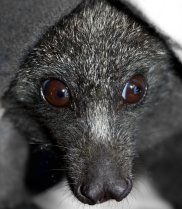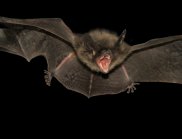Evolution of flying bat clue to cancer and viruses
Published today in the journal Science, the research provides an insight into the evolution of bat’s flight, resistance to viruses and relatively long life.
Researchers at CSIRO and the Beijing Genome Institute led a team sequencing the genomes of two bat species – an Australian mega bat, the black flying fox, and a Chinese micro bat, David’s Myotis. They then compared the bat genomes to the genomes of eight other mammals, including humans, to find similarities and differences.
This work continues CSIRO’s world leading position in research into bats and the viruses they harbour and is part of our wider biosecurity research effort to safeguard Australia and its people from exotic and emerging pests and diseases.
Dr Chris Cowled, post-doctoral fellow at CSIRO’s Australian Animal Health Laboratory, said the research may eventually lead to strategies to prevent or treat disease in humans.
“A deeper understanding of these evolutionary adaptations in bats may lead to better treatments for human diseases, and may eventually enable us to predict or perhaps even prevent outbreaks of emerging bat viruses,” Dr Cowled said.
“Bats are a natural reservoir for several lethal viruses, such as Hendra, Ebola and SARS, but they often don’t succumb to disease from these viruses. They’re also the only mammal that can fly, and they live a long time compared to animals similar in size,” Dr Cowled said.
“Flying is a very energy intensive activity that produces toxic by-products but we can see that bats have some novel genes to deal with these toxins,” he said.
Some of these genes, including P53, are implicated in the development of cancer or the detection and repair of damaged DNA.
“What we found intriguing was that some of these genes also have secondary roles in the immune system,” Dr Cowled said.
“We’re proposing that the evolution of flight led to a sort of spill over effect, influencing not only the immune system, but also things like ageing and cancer.”
The research also reaffirms bats’ ancient and important place in the eco-system, particularly as pollinators and controlling insect numbers.
“They’ve been around since the time of the dinosaurs, at least 65 million years, and they’re among the most abundant and widespread mammals on the earth.”
This work continues CSIRO’s world leading position in research into bats and the viruses they harbour and is part of our wider biosecurity research effort to safeguard Australia and its people from exotic and emerging pests and diseases.
The research was a global effort involving the Beijing Genome Institute in Shenzhen, China; Australia’s national science research agency, the CSIRO; the University of Copenhagen; Wuhan Institute of Virology at the Chinese Academy of Sciences; the Naval Medical Research Center and Henry M. Jackson Foundation in the USA; Uniformed Services University, USA; and the Graduate Medical School at the Duke-National University of Singapore.
Find out more
Media resources
Click image for high resolution version


